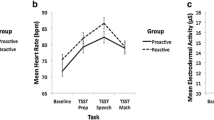Abstract
Our basic working hypothesis, and the unifying principle behind most of our experiments, has been the idea that frequently stressed individuals will show physiological hyperarousal in one or several bodily systems. A complementary hypothesis has been that frequently stressed (or overreactive individuals) are likely to lose the ability to relax well; i.e., to shift into a low arousal condition.
Presented in abridged form as presidential address by the first author at the Fourth Annual Meeting of the Biofeedback Research Society, November 1972, Boston, Massachusetts.
This research was supported by the Advanced Research Projects Agency of the Department of Defense and was monitored by the Office of Naval Research under Contract N00014-70-C-0350 to the San Diego State College Foundation, by National Institute of Mental Health Grant Number MH-15596, and Research Scientist Development Award Number K01-MH43361-01.
Access this chapter
Tax calculation will be finalised at checkout
Purchases are for personal use only
Preview
Unable to display preview. Download preview PDF.
Similar content being viewed by others
References
Batshan, I. D., 1962, Muscle tension and personality in women, Arch. Gen. Psychiat. 7: 436.
Budzynski, T. H., 1969, Feedback-induced muscle relaxation and activation level, unpublished doctoral dissertation, University of Colorado.
Budzynski, T. H., and Stoyva, J. M., 1969, An instrument for producing deep muscle relaxation by means of analog information feedback, J. Appt. Behay. Anal. 2: 231.
Budzynski, T. H., and Stoyva, J. M., I973a, A biofeedback technique for teaching voluntary relaxation of the masseter, J. Dental Res. 52: 116.
Budzynski, T. H., and Stoyva, J. M., 1973b, Biofeedback techniques in behavior therapy, in Neuropsychologie der Angst, (N. Birbaumer, ed.), “Reihe Fortschritte der Klinischen Psychologie,” Bd. 3, München, Wien: Verlag Urban and Schwarzenberg, pp. 248–270.
Budzynski, T. H., Stoyva, J. M., and Adler, C. S., 1970, Feedback-induced relaxation: Application to tension headache, J. Behay. Ther. Exptl. Psychiat. 1: 205.
Cannon, J., 1932, The Wisdom of the Body, Norton, New York.
Charvat, J., Dell, P., and Folkow, B., 1964, Mental factors and cardiovascular disorders, Cardiologia, 44:124.
Davis, J. F., 1959, Manual of Surface Electromyography, WADC Technical Report, No. 59–184.
Engel, B. T., Bickford, A. F., 1961, Response specificity, Arch. Gen. Psychiat. 5: 82.
Foulkes, D., 1966, The Psychology of Sleep, Scribner, New York.
Folkow, B., and Neil, E., 1971, Circulation, Oxford University Press, New York.
Green, E., Green, A., and Walters, D., 1970, Voluntary control of internal states: Psychological and physiological, J. Transpersonal Psychol. 1: 1.
Jacobson, E., 1938, Progressive Relaxation, University of Chicago Press, Chicago.
Jacobson, E., 1970, Modern Treatment of Tense Patients, Charles C. Thomas, Springfield, Illinois.
Lader, M. H., and Mathews, A. M., 1968, A physiological model of phobic anxiety and desensitization, Behay. Res. Ther. 6: 411.
Luthe, W., 1963, Autogenic training: Method, research, and application in medicine, Am. J. Psychozher. 17: 174.
Luthe, W., 1965, ed., Autogenic Training: Correlationes Psychosomaticae, Grune & Stratton, New York.
Luthe, W., 1969, ed., Autogenic Therapy, (Vols. I-V), Grune & Stratton, New York.
Maley, M. J., 1967, Two-flash threshold, skin conductance and skin potential, Psychon. Sci. 9: 361.
Malmo, R. B., 1966, Studies of anxiety: Some clinical origins of the activation concept, in Anxiety and Behavior ( C. D. Spielberger, ed.), pp. 157–177, Academic Press, New York.
Malmo, R. B., and Shagass, C., 1952, Studies of blood pressure in psychiatric patients under stress, Psychosom. Med. 14: 81.
Rechtshaffen, A., and Kates, A., 1968, A Manual of Standardized Terminology, Techniques, and Scoring Systems for Sleep Stages of Human Subjects, U.S. Dept. H.E.W., Bethesda, Maryland.
Rose, R. J., 1966, Anxiety and arousal: A study of two-flash fusion and skin conductance, Psychon. Sci. 6: 81.
Sainsbury, P., and Gibson, J. F., 1954, Symptoms of anxiety and tension and the accompanying physiological changes in the muscular system, J. Neurol. Neurosurg. Psychiat. 17: 216.
Shagass, C., and Malmo, R. B., 1954, Psychodynamic themes and localized muscular tension during psychotherapy, Psychosom. Med. 16: 295.
Shapiro, D., Tursky, B., Gershon, E., and Stern, M., 1969, Effects of feedback and reinforcement on the control of human systolic blood pressure, Science, 163: 588.
Sittenfeld, P., Budzynski, T. H., and Stoyva, J. M., 1972, Feedback control of the EEG theta rhythm, paper presented at the 1972 American Psychological Association meeting in Honolulu, Hawaii.
Sternbach, R. A., 1966, Principles of Psychophysiology: An Introductory Text and Readings, Academic Press, New York.
Venables, P. H., and Wing, J. K., 1962, Level of arousal and the subclassification of schizophrenia, Arch. Gen. Psychiat. 7: 114.
Wallace, R. K., and Benson, H., 1972, The physiology of meditation, Sci. Am. 226: 84.
Wenger, M. A., 1966, Studies of autonomic balance: A summary, Psychophysiol. 2: 173.
Wolff, H. G., 1963, Headache and Other Head Pain, Oxford University Press, New York.
Wolff, H. G., 1968, Harold G. Wolffs ‘Stress and Disease’, S. Wolf, ed., Charles C. Thomas, Springfield, Illinois.
Wolpe, J., 1958, Psychotherapy by Reciprocal Inhibition, Stanford University Press, Stanford.
Wolpe, J., and Lazarus, A. A., 1966 Behavior Therapy Techniques, Pergamon Press, New York.
Author information
Authors and Affiliations
Rights and permissions
Copyright information
© 1974 Plenum Press, New York
About this chapter
Cite this chapter
Stoyva, J., Budzynski, T. (1974). Cultivated Low Arousal—An Antistress Response?. In: Limbic and Autonomic Nervous Systems Research. Springer, Boston, MA. https://doi.org/10.1007/978-1-4613-4407-0_11
Download citation
DOI: https://doi.org/10.1007/978-1-4613-4407-0_11
Publisher Name: Springer, Boston, MA
Print ISBN: 978-1-4613-4409-4
Online ISBN: 978-1-4613-4407-0
eBook Packages: Springer Book Archive




